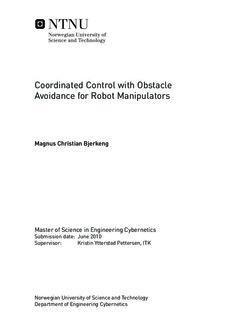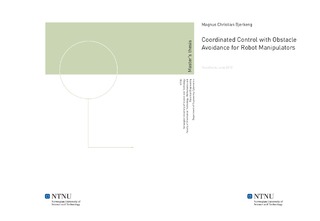| dc.contributor.advisor | Pettersen, Kristin Ytterstad | nb_NO |
| dc.contributor.author | Bjerkeng, Magnus Christian | nb_NO |
| dc.date.accessioned | 2014-12-19T14:02:06Z | |
| dc.date.available | 2014-12-19T14:02:06Z | |
| dc.date.created | 2010-09-03 | nb_NO |
| dc.date.issued | 2010 | nb_NO |
| dc.identifier | 347988 | nb_NO |
| dc.identifier | ntnudaim:5429 | nb_NO |
| dc.identifier.uri | http://hdl.handle.net/11250/259824 | |
| dc.description.abstract | This thesis addresses the problem of robot synchronization with obstacle avoidance. While these two fields have been studied extensively on their own, they have not yet been considered together as one problem. This thesis is divided roughly into four parts which are to some extent self contained. The theory is presented in a narrative that culminates with the stability proof of the proposed controller. Examples and figures are used in order to keep the material manageable and readable. The introductory part of the thesis consists of chapters 1 and 2. We present the notation and some mathematical background which is necessary for the theoretical analysis. We go on to review the diversity of ways in which one may approach this problem from a control design standpoint. We derive the robot dynamical model in chapter 3 as well as solve other modeling specific problems. This chapter is of little theoretical interest, but is needed to implement a simulator on which we may test our controller. This chapter contains no new contributions but can be read as a guide to robot modeling. The first contributions in this thesis are found in chapter 4 where we propose a real time implementable solution for solving the shortest distance estimation problem. It is important to know the distance to an obstacle in order to avoid it. The solution is a dynamic implementation of a steepest descent optimization scheme which is suitable to run on-line. Chapter 5 is an introduction to the involved control design found in chapter 6. We review results from obstacle avoidance literature and argue for our choice of using the task space control design method. The main contribution of this thesis is found in chapter 6. A controller is developed and is shown to produce a stable closed loop system. We first develop a controller considering only collision for the end effector, and then we extend this to work with full robot collision. The response of the robot is such that it will track a reference trajectory whenever it is locally possible. When one cannot track the reference trajectory because of obstacles hindering the movement, then the trajectory is tracked in all directions in which the robot can move freely. The controller is simple and elegant, and does not rely on heuristics common in traditional solutions to obstacle avoidance control. | nb_NO |
| dc.language | eng | nb_NO |
| dc.publisher | Institutt for teknisk kybernetikk | nb_NO |
| dc.subject | ntnudaim | no_NO |
| dc.subject | SIE3 teknisk kybernetikk | no_NO |
| dc.subject | Reguleringsteknikk | no_NO |
| dc.title | Coordinated Control with Obstacle Avoidance for Robot Manipulators | nb_NO |
| dc.type | Master thesis | nb_NO |
| dc.source.pagenumber | 123 | nb_NO |
| dc.contributor.department | Norges teknisk-naturvitenskapelige universitet, Fakultet for informasjonsteknologi, matematikk og elektroteknikk, Institutt for teknisk kybernetikk | nb_NO |

